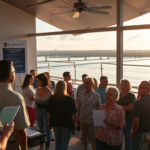Colombian Government Plane Sighting Raises Questions in Harlingen
A recent event captured the attention of Valley residents and added a layer of intrigue to ongoing local discussions about immigration and international relations. A Colombian government plane was observed departing Valley International Airport in Harlingen, sparking curiosity and speculation throughout the community.
Key Developments: Plane Departure Monitored
The sighting occurred against a backdrop of multinational dialogues and diplomatic tensions. According to eyewitness reports and Channel 5 News footage, the plane left Harlingen without any visible passengers boarding or disembarking from the three government buses stationed nearby. U.S. Customs and Border Protection officials were present, fueling speculation about the nature of the flight.
This sighting coincides with the recent resumption of deportation flights between the U.S. and Colombia, following a temporary halt prompted by a diplomatic dispute regarding migrant expulsions. The standoff was ignited when Colombian President Gustavo Petro refused to accept expelled migrants from the United States, citing concerns over treatment protocols and ultimately calling for assurances of dignified handling.
Community Perspectives and Local Concerns
The Rio Grande Valley, a region marked by its rich cultural diversity and proximity to international borders, has always been attuned to immigration-related events. This recent development has not gone unnoticed by RGV residents, many of whom have personal or familial ties to migration narratives.
Lorena Salinas, an immigration advocate based in McAllen, weighs in on the situation. “For many in the Valley, stories like these hit close to home. They remind us of the complexity and human element involved in immigration discussions. It’s crucial that any operations carried out here uphold our community’s values of dignity and respect,” she remarked.
Meanwhile, Andres Perez, an economist who studies South Texas’s cross-border dynamics, sees broader implications. “Events like these could influence local perceptions and, subsequently, policy decisions impacting border communities. Our area is particularly sensitive to shifts in immigration policy and international relations. It’s a narrative that’s deeply interconnected with our local economy and social fabric,” he noted.
Potential Impacts on the RGV
For the RGV, this incident highlights ongoing issues around border management and international diplomacy. As local officials and community members continue to monitor such flights, there are questions about how immigration policies might evolve.
Javier Martinez, a local historian, draws parallels to previous policies and actions that have affected the Valley. “The resumption of these flights brings to mind past waves of immigration reform and enforcement. Each time, our communities have adapted, showing resilience but also experiencing growing pains. History teaches us that transparency and engagement with policymakers are vital,” he shared.
As Mexico increases its border security presence, deploying 1,000 National Guard members to Matamoros following talks with former President Trump, discussions around immigration enforcement take on renewed urgency. These measures have corresponded with a reduction in border crossings, yet the community remains watchful about long-term impacts.
Bridging the Divide: Calls for Community Dialogue
In light of these developments, local leaders and organizations emphasize the importance of dialogue. Addressing questions and concerns related to migration and its facets can foster understanding and inform better policy-making.
Lisa Rodriguez, a counselor working with immigrant families, advocates for community-centered approaches. “It’s crucial that we have open spaces to discuss these issues. We must listen to those who are directly affected by these policies and, collectively, advocate for fair and humane solutions,” she expressed.
Resources and Future Engagement Opportunities
For residents seeking to engage further, a series of town hall meetings is planned throughout the RGV to discuss immigration and community relations. These forums are designed to facilitate conversation between residents, local government, and key stakeholders, ensuring that the voices of Valley residents are heard and considered.
In conclusion, the sighting of the Colombian government plane at Valley International Airport serves as a reminder of the interconnectedness of local and global events in the RGV. As this story unfolds, it remains a testament to the region’s ability to navigate complexities with resilience and a commitment to community well-being. Valley residents are encouraged to stay informed and participate in upcoming discussions to better understand the impacts of policies affecting them locally and globally.







